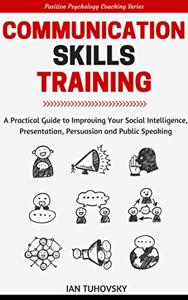
Want to learn the ideas in Communication Skills better than ever? Read the world’s #1 book summary of Communication Skills by Ian Tuhovsky and Wendell Wadsworth here.
Read a brief 1-Page Summary or watch video summaries curated by our expert team. Note: this book guide is not affiliated with or endorsed by the publisher or author, and we always encourage you to purchase and read the full book.
Video Summaries of Communication Skills
We’ve scoured the Internet for the very best videos on Communication Skills, from high-quality videos summaries to interviews or commentary by Ian Tuhovsky and Wendell Wadsworth.
1-Page Summary of Communication Skills
Communicating with Confidence
Good communication is essential to teamwork, interdependence and shared responsibility. These are characteristics that define a successful business. In contrast, poor communication leads to lost opportunities, reduced profits and low morale. To ensure the success of your business or team, you need to improve your communication skills.
Communication is the sharing of thoughts, ideas and feelings with others. The Latin word for communication is communicare, which means to make common or share. So good communication has little to do with having a large vocabulary but more about being able to share your meaning with others.
There are three principles to remember when communicating.
- Communication is learned behavior. The quality of your communication skills determines the quality of your relationships. When you practice, you’ll perfect new skills. There are many types of communication skills, including listening, assertiveness, nonverbal communication, time management and writing. Some examples include accepting compliments and criticisms or problem solving and conflict resolution.
The internet has created new opportunities for business communication. E-mail is one of the most commonly used forms of communication, as well as IRC (Internet Relay Chat). These skills can be improved through practice.
It’s All in the Delivery
Human communication can be divided into three categories: passive, aggressive and assertive. Passive communication is when you don’t speak up for yourself or aren’t confident in your opinions. Aggressive communication causes hurt and humiliation to the other person. Assertive communication is a middle ground between these two extremes that allows both parties to express themselves without hurting anyone else’s feelings.
Assertive communication requires you to be honest and clear about your feelings. It’s important to tell the other person how they’re affecting you, what you want and why it matters.
Remember, how you say something is as important as what you say. Tone, inflection and facial expressions account for 93% of your message, with the actual words accounting for only the remaining 7%. The key components to successful nonverbal communication are eye contact, body posture, distance/physical contact (how close or far apart people stand), facial expressions (smiling when happy) hand gestures, vocal tone (using high-pitched voices when excited), inflection and volume (speaking loudly when angry or softly in a calm manner). These components form the basis for developing a personal style that enhances the delivery of messages.
Stupid Talk
When Roman Hruska was asked to argue for the nomination of a Supreme Court candidate, he said that there are so many mediocre people in America that they’re entitled to be represented by a mediocre judge. He regretted his statement because it caused an uproar among Americans.
Even with the best of intentions, there are times when you might say or do something completely inappropriate. To avoid such embarrassing and counter-productive slip-ups, listen for evidence of your own stupid talk. If you catch yourself veering from the course of productive communication, replay the conversation in your mind and determine how to express your thoughts more effectively.
Mars Calling Venus… Come in Venus
Men and women communicate differently. They use different language because of their upbringing, biology or a combination of the two. Regardless of why this happens, it is important to recognize that gender communication differences exist.





